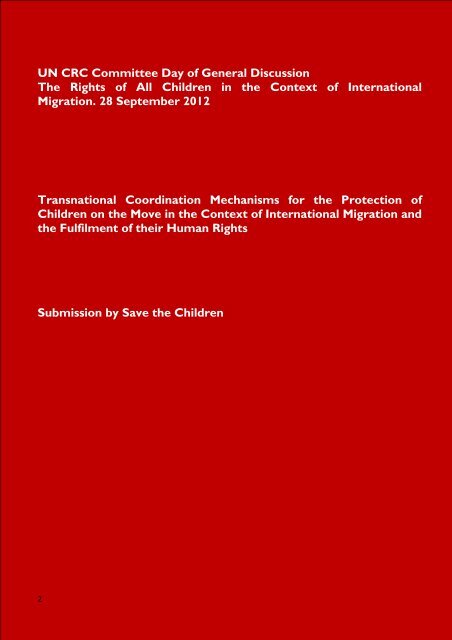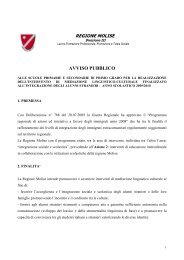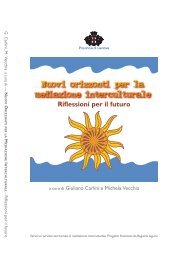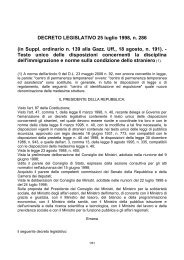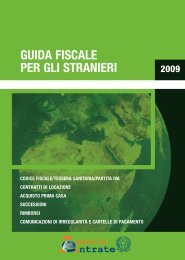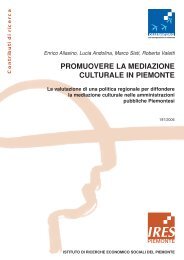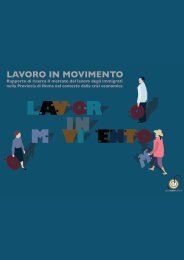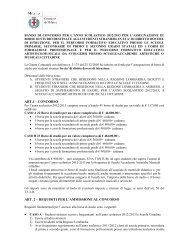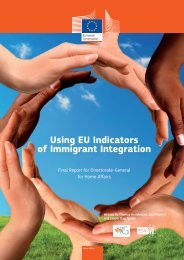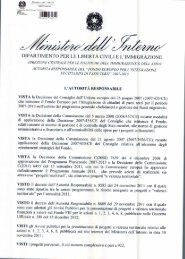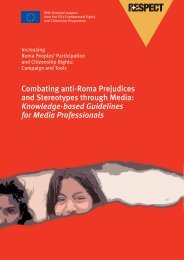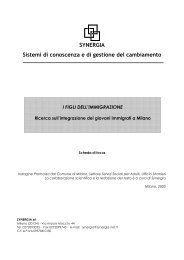1 - Office of the High Commissioner for Human Rights
1 - Office of the High Commissioner for Human Rights
1 - Office of the High Commissioner for Human Rights
You also want an ePaper? Increase the reach of your titles
YUMPU automatically turns print PDFs into web optimized ePapers that Google loves.
UN CRC Committee Day <strong>of</strong> General DiscussionThe <strong>Rights</strong> <strong>of</strong> All Children in <strong>the</strong> Context <strong>of</strong> InternationalMigration. 28 September 2012Transnational Coordination Mechanisms <strong>for</strong> <strong>the</strong> Protection <strong>of</strong>Children on <strong>the</strong> Move in <strong>the</strong> Context <strong>of</strong> International Migration and<strong>the</strong> Fulfilment <strong>of</strong> <strong>the</strong>ir <strong>Human</strong> <strong>Rights</strong>Submission by Save <strong>the</strong> Children2
IntroductionAddressing <strong>the</strong> rights and needs <strong>of</strong> children involved in international migration requires first <strong>of</strong> all that <strong>the</strong>irrights and needs as children are fully recognised. Increasingly States, particularly countries <strong>of</strong> transit or destination<strong>of</strong> migration flows, are recognising <strong>the</strong>ir child rights obligations to children on <strong>the</strong> move.However, much more needs to be done to translate this into a real difference to <strong>the</strong> lives <strong>of</strong> <strong>the</strong>se children. It is<strong>the</strong>re<strong>for</strong>e timely and very welcome that <strong>the</strong> United Nations Committee on <strong>the</strong> <strong>Rights</strong> <strong>of</strong> <strong>the</strong> Child’s Day <strong>of</strong>General Discussion is putting <strong>the</strong> situation <strong>of</strong> <strong>the</strong>se children under <strong>the</strong> spotlight, and will consider carefully how<strong>the</strong>ir rights under <strong>the</strong> UN Convention on <strong>the</strong> <strong>Rights</strong> <strong>of</strong> <strong>the</strong> Child can be realised.While international law defines a child as “every human being below <strong>the</strong> age <strong>of</strong> eighteen”, no single internationallegal definition <strong>of</strong> a migrant – and <strong>the</strong>re<strong>for</strong>e <strong>of</strong> a migrant child – exists. Never<strong>the</strong>less, many discrete types <strong>of</strong> childmigration – family-based, unaccompanied, irregular, trafficked, asylum-related – have been <strong>the</strong> focus <strong>of</strong> national,regional and international attention. Despite <strong>the</strong> differences, <strong>the</strong>y all include situations where children might beat risk <strong>of</strong> being exposed to abuse, neglect, violence or exploitation.The circumstances <strong>of</strong> migrant children who are unaccompanied by or are separated from <strong>the</strong>ir normal carers hasbeen a particular concern. Never<strong>the</strong>less, children on <strong>the</strong> move who are accompanied by <strong>the</strong>ir normal carers mayalso have protection needs, particularly where <strong>the</strong>ir carers are irregular migrants or where <strong>the</strong> family aredestitute, conflict-affected refugees who have not adapted to <strong>the</strong>ir new surroundings.Given <strong>the</strong> commonality in <strong>the</strong> protection needs <strong>of</strong> children involved in mixed migration flows, Save <strong>the</strong> Childrenadopts a holistic focus on child migration, using <strong>the</strong> following umbrella definition <strong>of</strong> children on <strong>the</strong> move:“Those children moving <strong>for</strong> a variety <strong>of</strong> reasons, voluntarily or involuntarily, within or betweencountries, with or without <strong>the</strong>ir parents or o<strong>the</strong>r primary caregivers, and whose movementmight place <strong>the</strong>m at risk (or at an increased risk) <strong>of</strong> economic or sexual exploitation, abuse,neglect and violence”.This definition brings toge<strong>the</strong>r children who have been trafficked; asylum seeking children, children who migrate(eg, to pursue better life opportunities; to look <strong>for</strong> work or education; to reunite with family; or to escapeexploitative or abusive situations at home); children displaced by conflict and natural disasters; and children wholive and work in <strong>the</strong> streets.The need <strong>for</strong> transnational cooperation to protect children on <strong>the</strong> moveAll States have an obligation to respect and ensure <strong>the</strong> human rights <strong>of</strong> all children, including children on <strong>the</strong>move. An appropriate response to <strong>the</strong> needs <strong>of</strong> children who move across international borders <strong>of</strong>ten relies notonly on national laws and policies but also on effective transnational cooperation between public and privateactors, based on <strong>the</strong> best interests <strong>of</strong> <strong>the</strong> child. Situations requiring transnational cooperation between a range <strong>of</strong>actors occur throughout <strong>the</strong> migration cycle, yet insufficient attention has so far been paid to what is needed t<strong>of</strong>acilitate and support this transnational collaboration.Drawing on Save <strong>the</strong> Children’s field experience, this paper reflects on <strong>the</strong> impact and implications <strong>of</strong>transnational cooperation on <strong>the</strong> protection and promotion <strong>of</strong> <strong>the</strong> rights <strong>of</strong> children on <strong>the</strong> move. Ra<strong>the</strong>r thanproviding definitive answers it aims to suggest points <strong>for</strong> reflection among <strong>the</strong> many stakeholders involved on <strong>the</strong>scope <strong>of</strong> transnational cooperation between States, and to prompt a common consideration <strong>of</strong> how <strong>the</strong> humanrights <strong>of</strong> children on <strong>the</strong> move can be more effectively fulfilled through such cooperation.2
Achieving transnational cooperation to fulfil <strong>the</strong> rights <strong>of</strong> children on <strong>the</strong> move:<strong>the</strong> challengeAppropriate responses to protect and promote <strong>the</strong> rights <strong>of</strong> children on <strong>the</strong> move <strong>of</strong>ten require interventions ateach stage <strong>of</strong> <strong>the</strong>ir journey and implicate a range <strong>of</strong> actors <strong>of</strong>ten in different countries. Effective coordinationbetween <strong>the</strong>se actors across different countries is <strong>of</strong>ten crucial to prevent or reduce <strong>the</strong> risks <strong>of</strong> unsafeinternational migration; ensure that children are properly identified, receive immediate assistance and have <strong>the</strong>ircare needs met; and find and implement durable solutions.Transnational cooperation – across disparate legal, political and linguistic boundaries – is complex. As a result itoccurs less frequently and less effectively than required. Indeed, this lack <strong>of</strong> transnational cooperation issometimes used by States as an excuse to justify <strong>the</strong>ir failures to protect children on <strong>the</strong> move. We wish tounderline that <strong>the</strong> absence <strong>of</strong> transnational cooperation can never justify <strong>the</strong> failure <strong>of</strong> a country <strong>of</strong> transit ordestination to provide temporary assistance and care, nor can it justify <strong>the</strong> summary deportation or detention <strong>of</strong>a child.Equally, Save <strong>the</strong> Children believes that engaged stakeholders should reflect carefully toge<strong>the</strong>r on how to ensuremore systematic attention is paid to surmounting <strong>the</strong> obstacles to transnational cooperation, based on acommon child rights and child protection agenda.Our experience suggests that <strong>the</strong> existence and efficacy <strong>of</strong> transnational cooperation vary considerably because<strong>of</strong> a variety <strong>of</strong> factors. Some regional mechanisms and bilateral agreements affect certain categories <strong>of</strong> childrenon <strong>the</strong> move – in particular, trafficked children. However, many categories <strong>of</strong> children on <strong>the</strong> move remainoutside protection mechanisms. As a result, States’ obligation to promote, protect and fulfil <strong>the</strong>se children’shuman rights remains unrealised.In some instances obstacles to transnational cooperation derive from <strong>the</strong> absence <strong>of</strong> a common understandingbetween States <strong>of</strong> what child rights and protection issues are involved. On o<strong>the</strong>r occasions, actors lack <strong>the</strong>capacity – and <strong>the</strong> resources – to communicate effectively across <strong>the</strong>ir respective linguistic, legal andgeographical borders.Failure to cooperate on child protection concerns is sometimes <strong>the</strong> product <strong>of</strong> powerful migration controlpressures in <strong>the</strong> political agenda which obscures <strong>the</strong> urgency <strong>of</strong> <strong>the</strong> child rights issues at stake. In particular,national child protection systems and actors are frequently not engaged with each o<strong>the</strong>r transnationally torespond to <strong>the</strong> situation <strong>of</strong> <strong>the</strong>se children. Failure can also occur because <strong>of</strong> an absence <strong>of</strong> facilitatoryinternational mechanisms, backed up by appropriate training and transnational capacity building. Transnationalcooperation may also be impeded by sensitivities in situations where children are escaping persecution, or where<strong>the</strong>re are o<strong>the</strong>r harm or data protection concerns.The sections that follow is a reflection on <strong>the</strong> legal and practical challenges to transnational cooperation and<strong>the</strong>ir implications <strong>for</strong> <strong>the</strong> protection and fulfilment <strong>of</strong> <strong>the</strong> rights <strong>of</strong> children on <strong>the</strong> move.The international legal framework <strong>for</strong> transnational cooperation and <strong>the</strong> rights <strong>of</strong>children in international migration: a brief overviewWhat follows is an initial overview – ra<strong>the</strong>r than a comprehensive analysis – <strong>of</strong> <strong>the</strong> underlying principles andguidelines emerging from key instruments within <strong>the</strong> international legal framework governing <strong>the</strong> protection <strong>of</strong>children and migrants. Its aim ultimately is to stimulate pointers <strong>for</strong> future research and inquiry.3
The UN Convention on <strong>the</strong> <strong>Rights</strong> <strong>of</strong> <strong>the</strong> ChildThe UN Convention on <strong>the</strong> <strong>Rights</strong> <strong>of</strong> <strong>the</strong> Child addresses <strong>the</strong> rights <strong>of</strong> all children falling within <strong>the</strong> jurisdiction<strong>of</strong> a State, regardless <strong>of</strong> <strong>the</strong>ir nationality or immigration status. It consolidates provisions in o<strong>the</strong>r internationaltreaties ins<strong>of</strong>ar as <strong>the</strong>y are relevant to children. 1 Although <strong>the</strong> UNCRC does not contain specific provisionsconcerning <strong>the</strong> rights <strong>of</strong> migrant children in general, it does contain some specific provisions on certain groups <strong>of</strong>children on <strong>the</strong> move, including refugee children, children who have been trafficked, and children who have beendeprived <strong>of</strong> <strong>the</strong>ir family environment. However, its general provisions apply fully to migrant children withoutdiscrimination.Some <strong>of</strong> <strong>the</strong> norms in <strong>the</strong> UN CRC that apply to all children are particularly relevant to children on <strong>the</strong> move,and to <strong>the</strong> question <strong>of</strong> States’ obligations to engage in transnational cooperation to fully protect <strong>the</strong>ir rights andneeds as required by <strong>the</strong> convention. Article 3 <strong>of</strong> <strong>the</strong> UNCRC – which requires State Parties to take <strong>the</strong> bestinterests <strong>of</strong> <strong>the</strong> child as a primary consideration in all actions in its regard – is a central provision and its fullapplication requires in many cases effective transnational cooperation to ensure that appropriate care andprotection solutions <strong>for</strong> all children, including children on <strong>the</strong> move are put in place.O<strong>the</strong>r relevant norms include: <strong>the</strong> prohibition on discrimination, both between adults and children, and betweendifferent groups (and ages) <strong>of</strong> children; <strong>the</strong> promotion and protection <strong>of</strong> <strong>the</strong> right to freedom <strong>of</strong> movement; <strong>the</strong>right to acquire a nationality, and <strong>the</strong> correlative obligation to avoid statelessness; <strong>the</strong> promotion and protection<strong>of</strong> a broad range <strong>of</strong> economic, social and cultural rights, and <strong>the</strong> rights to education, health and shelter; <strong>the</strong>prohibition <strong>of</strong> arbitrary arrest and detention, and <strong>the</strong> requirement that children only be subject to detention “asa measure <strong>of</strong> last resort and <strong>for</strong> <strong>the</strong> shortest possible period <strong>of</strong> time”, <strong>the</strong> protection from all <strong>for</strong>ms <strong>of</strong> violenceand <strong>the</strong> prohibition <strong>of</strong> use <strong>of</strong> torture or o<strong>the</strong>r cruel, inhuman or degrading treatment or punishment, <strong>the</strong>protection <strong>of</strong> family unity (which includes both <strong>the</strong> negative obligation not to interfere with family unity and <strong>the</strong>positive obligation to take all necessary measures to assure realization <strong>of</strong> <strong>the</strong> child’s right to family unity).Additionally, <strong>the</strong> General Comment No 6 <strong>of</strong> <strong>the</strong> UN Committee on <strong>the</strong> <strong>Rights</strong> <strong>of</strong> <strong>the</strong> Child on unaccompaniedand separated children outside <strong>the</strong>ir country <strong>of</strong> origin addresses <strong>the</strong> application <strong>of</strong> <strong>the</strong> CRC as a wholespecifically to <strong>the</strong>se children, regardless <strong>of</strong> <strong>the</strong> reasons behind <strong>the</strong>ir movement. This guidance includes <strong>the</strong>recognition that at <strong>the</strong> earliest possible opportunity all children should be indentified; should have access t<strong>of</strong>amily tracing and restoration <strong>of</strong> family or community links where this is <strong>the</strong>ir best interests; should be assigned acompetent guardian and access to legal assistance; should have a decision made concerning where <strong>the</strong>y should beplaced in <strong>the</strong> immediate and short-term; and should have access to justice. Transnational cooperation andcollaboration is essential to ensure <strong>the</strong> realisation in practice <strong>of</strong> many <strong>of</strong> <strong>the</strong>se obligations.A number <strong>of</strong> provisions in <strong>the</strong> UN CRC explicitly address transnational cooperation between States. Some <strong>of</strong><strong>the</strong>m directly address provisions in <strong>the</strong> field <strong>of</strong> child protection, including <strong>the</strong> requirements <strong>of</strong> States to take allappropriate national, bilateral and multilateral measures to: protect children from sexual exploitation and abuse;prevent <strong>the</strong> abduction <strong>of</strong>, <strong>the</strong> sale <strong>of</strong> or traffic in children; ensure that inter-country adoption is carried out onlyby competent authorities; and ensure <strong>the</strong> appropriate protection <strong>for</strong> children who are seeking refugee status orwho are considered a refugee (CRC Articles. 21, 22, 34, 35).1 These include <strong>the</strong> o<strong>the</strong>r core international human rights instruments, namely: International Convention on <strong>the</strong> Elimination <strong>of</strong> All Forms <strong>of</strong>Racial Discrimination, International Covenant on Civil and Political <strong>Rights</strong>, International Covenant on Economic, Social and Cultural <strong>Rights</strong>,Convention on <strong>the</strong> Elimination <strong>of</strong> All Forms <strong>of</strong> Discrimination against Women, Convention against Torture and O<strong>the</strong>r Cruel, Inhuman orDegrading Treatment or Punishment. O<strong>the</strong>r relevant international instruments include: <strong>the</strong> International Convention on <strong>the</strong> Protection <strong>of</strong> AllMigrant Workers and Members <strong>of</strong> <strong>the</strong>ir Families; ILO Conventions No 97 and No 143 on <strong>the</strong> rights <strong>of</strong> Migrant Workers; ILO Conventions No.138 and 182 on minimum age and worst <strong>for</strong>ms <strong>of</strong> child labour); Convention relating to <strong>the</strong> status <strong>of</strong> Refugees; Convention on Reduction <strong>of</strong>Statelessness; Palermo Protocol on Trafficking <strong>of</strong> persons; and regional instruments.4
O<strong>the</strong>r international legal provisions relevant to transnational cooperationO<strong>the</strong>r special international instruments address <strong>the</strong> protection and transnational cooperation obligations thatarise in relation to child refugees and child victims <strong>of</strong> trafficking. By requiring state parties to refrain fromrefoulement 2 and to engage in protection <strong>of</strong> substantive rights, <strong>the</strong>se instruments may implicate transnationalmechanisms. For example, <strong>the</strong>se may be needed to elicit important in<strong>for</strong>mation about <strong>the</strong> country <strong>of</strong> origin, and<strong>the</strong> harms that <strong>the</strong> migrant child has been exposed to in <strong>the</strong> past or <strong>the</strong> risks he or she might incur into in <strong>the</strong>future. This in<strong>for</strong>mation may be important to explore where <strong>the</strong> best interests <strong>of</strong> <strong>the</strong> child lie, and <strong>the</strong>y may becritical to ef<strong>for</strong>ts such as family tracing or identification, restoring family contacts, family reunification, oravoidance <strong>of</strong> <strong>the</strong> risk <strong>of</strong> retrafficking. 3Some international legal instruments also address <strong>the</strong> rights <strong>of</strong> children who are internationally adopted orabducted. Both <strong>the</strong> Hague Convention on <strong>the</strong> Protection <strong>of</strong> Children and Cooperation in Respect <strong>of</strong> Inter-Country Adoption 4 and <strong>the</strong> 1996 Hague Convention on parental responsibility and protection <strong>of</strong> children 5 ,contain detailed references to transnational cooperation mechanisms designed to protect children moved incircumstances covered by <strong>the</strong>ir provisions.Multilateral and Bilateral AgreementsIn addition to international covenants, multilateral and bilateral agreements exist between many sending, transitand receiving countries in order to direct <strong>the</strong> treatment <strong>of</strong> regular and irregular migrants, including children on<strong>the</strong> move and raising questions related to transnational cooperation.These include European Union (EU) legislation addressing <strong>the</strong> transfer <strong>of</strong> children within <strong>the</strong> EU <strong>for</strong> <strong>the</strong> purposes<strong>of</strong> assigning responsibility to a Member State to examine an asylum application (Dublin II Regulation) 6 . The EUhas also signed general Readmission Agreements with a variety <strong>of</strong> countries including Turkey and <strong>the</strong> Ukraine.O<strong>the</strong>r examples <strong>of</strong> multilateral or bilateral agreements affecting children on <strong>the</strong> move include Memoranda <strong>of</strong>Understanding (MoUs) between countries. Examples include: <strong>the</strong> MoUs concluded by <strong>the</strong> United NationsMission in Kosovo (UNMIK), prior to <strong>the</strong> declaration <strong>of</strong> independence in 2008, regarding <strong>the</strong> readmission <strong>of</strong>irregular migrants and unsuccessful asylum applicants which gives particular attention to separated childrenwithout caregivers in Kosovo; <strong>the</strong> numerous MoUs developed between countries in <strong>the</strong> Greater Mekong Sub-Region 7 addressing trafficking and <strong>the</strong> Coordinated Mekong Ministerial Initiative against Trafficking (COMMIT). 8Some <strong>of</strong> <strong>the</strong>m, such as <strong>the</strong> MoU between Vietnam, Lao and Myanmar with Thailand, aim at facilitating familytracing, safety assessment, and preparation <strong>for</strong> <strong>the</strong> return <strong>of</strong> victims <strong>of</strong> trafficking, including children, to <strong>the</strong>irfamilies.However many <strong>of</strong> <strong>the</strong>se agreements, or <strong>the</strong>ir implementation, have been criticized <strong>for</strong> ei<strong>the</strong>r lacking adequatechild protection safeguards or <strong>for</strong> gaps in <strong>the</strong>ir coordination mechanisms to ensure that such safeguards are2 ‘Refoulement’ refers to <strong>the</strong> expulsion or return <strong>of</strong> a refugee from one state to ano<strong>the</strong>r where his life or liberty would be threatened.3 See in this respect provisions included in <strong>the</strong> 1951Genveva Convention and 1967 Protocol Relating to <strong>the</strong> Status <strong>of</strong> Refugees , <strong>the</strong> UN Protocol toPrevent, Suppress and Punish Trafficking in Persons, Especially Women and Children, supplementing <strong>the</strong> United Nations Convention Against TransnationalOrganized Crime, 2000; and <strong>the</strong> Council <strong>of</strong> Europe Convention on Action against Trafficking in <strong>Human</strong> Beings, particularly Artt 10 to 17 on Measures toprotect and promote <strong>the</strong> rights <strong>of</strong> victims, guaranteeing gender equality.4 Hague Convention on <strong>the</strong> Protection <strong>of</strong> Children and Co-operation in Respect <strong>of</strong> Inter-country Adoption, 29 May 1993,5 Convention <strong>of</strong> 19 October 1996 on Jurisdiction, Applicable Law, Recognition, En<strong>for</strong>cement and Co-operation in respect <strong>of</strong> Parental Responsibility andMeasures <strong>for</strong> <strong>the</strong> Protection <strong>of</strong> Children6 Council Regulation (EC) No 343/2003 <strong>of</strong> 18 February 2003 establishing <strong>the</strong> criteria and mechanisms <strong>for</strong> determining <strong>the</strong> Member State responsible <strong>for</strong>examining an asylum application lodged in one <strong>of</strong> <strong>the</strong> Member States by a third-country national.7 The sub-region includes six countries along <strong>the</strong> Mekong river: Thailand, Myanmar, Laos, Cambodia, Yunnan Province <strong>of</strong> China and Vietnam.8 These include: Lao PDR – Vietnam, MOU on Cooperation in Preventing and Combating Trafficking in Persons and Protection <strong>of</strong> Victims <strong>of</strong> Trafficking, 3November 2010; Cambodia – Thailand, MOU on Bilateral Cooperation in Eliminating Trafficking in Children and Women and Assisting Victims <strong>of</strong>Trafficking, 31 May 2003; Myanmar – Thailand, MOU on Cooperation to Combat Trafficking in Persons, Especially Women and Children, 2009; Cambodia– Vietnam, Bilateral Cooperation <strong>for</strong> Eliminating Trafficking in Women and Children and Assisting Victims <strong>of</strong> Trafficking; Thailand – Vietnam Cooperationto Eliminate Trafficking in Persons5
implemented appropriately. In <strong>the</strong> case <strong>of</strong> <strong>the</strong> Kosovo agreements, <strong>for</strong> example, <strong>the</strong> coordination betweenreadmission and reintegration segments remains inadequate, and as a result protection gaps persist 9 . To date “nolegal provisions regulate family tracing, family care or o<strong>the</strong>r assessments in <strong>the</strong> context <strong>of</strong> children’s return” 10 .This brief survey <strong>of</strong> <strong>the</strong> international legal framework shows that in order to fulfil many <strong>of</strong> <strong>the</strong> obligationsincluded in international instruments that apply to children, including children on <strong>the</strong> move, transnationalcooperation is <strong>of</strong>ten necessary. However, <strong>the</strong> lack <strong>of</strong> explicit and coordinated provisions <strong>for</strong> transnationalcooperation that emerges from this analysis also raises questions as to what fur<strong>the</strong>r steps are necessary to fosterbetter and appropriate cooperation. Fur<strong>the</strong>r considerations on <strong>the</strong> underlying principles <strong>of</strong> <strong>the</strong> international legalframework will help an exploration <strong>of</strong> <strong>the</strong> scope, and appropriate actors and means, <strong>for</strong> such cooperation.Why International Cooperation Mechanisms Matter: evidence fromSave <strong>the</strong> Children’s workSave <strong>the</strong> Children’s experience in working with children on <strong>the</strong> move in various regions shows that <strong>the</strong>protection and fulfilment <strong>of</strong> <strong>the</strong>ir rights <strong>of</strong>ten requires contacts and collaboration between public and privateactors who work in different countries.This section presents examples <strong>of</strong> key situations which demonstrate how transnational cooperation - or <strong>the</strong> lack<strong>of</strong> it - can affect actions aimed at guaranteeing <strong>the</strong> rights <strong>of</strong> children on <strong>the</strong> move. The examples and case studiespresented below are based on Save <strong>the</strong> Children’s field experience. They are not intended to provide anexhaustive analysis <strong>of</strong> challenges and protection gaps. Ra<strong>the</strong>r, <strong>the</strong>y exemplify situations where effectivetransnational cooperation between state and non state actors is crucial <strong>for</strong> <strong>the</strong> implementation <strong>of</strong> measuresbased on <strong>the</strong> best interests <strong>of</strong> <strong>the</strong> child. And <strong>the</strong>y demonstrate how <strong>the</strong> absence <strong>of</strong> a framework that fostersproper cooperation between States, based on a common child rights and child protection agenda, hinders <strong>the</strong>realization <strong>of</strong> <strong>the</strong> rights <strong>of</strong> children on <strong>the</strong> move.Preventing <strong>the</strong> need <strong>for</strong>, and mitigating <strong>the</strong> risks <strong>of</strong>, unsafe migration in countries <strong>of</strong> origin.Preventing <strong>the</strong> need <strong>for</strong> unsafe migration, including reducing <strong>the</strong> risks associated with it, is a fundamental buildingblock <strong>of</strong> an international system that respects human rights. A range <strong>of</strong> social and economic developmentinterventions – which would benefit from transnational cooperation – are <strong>the</strong>re<strong>for</strong>e required. Theseinterventions include partnerships to bolster national child protection systems and to foster educational, trainingand employment opportunities <strong>for</strong> children and adolescents in countries <strong>of</strong> origin. Transnational cooperation in<strong>the</strong>se partnerships involves collaboration between actors in countries <strong>of</strong> destination, transit and origin todevelop and finance appropriate structures that provide young people with opportunities to flourish.The preamble to <strong>the</strong> CRC notes “<strong>the</strong> importance <strong>of</strong> international cooperation <strong>for</strong> improving <strong>the</strong> living conditions<strong>of</strong> children in every country, in particular in <strong>the</strong> developing countries”. In addition, many international andregional agreements on trafficking and migration refer to <strong>the</strong> importance addressing <strong>the</strong> ‘root causes <strong>of</strong>migration’. However, <strong>the</strong> allocation <strong>of</strong> budget lines to tackle <strong>the</strong>se root causes is still scarce.One example <strong>of</strong> international collaboration to prevent unsafe migration is <strong>the</strong> collaboration between <strong>the</strong> EU and<strong>the</strong> Government <strong>of</strong> Egypt that aims to improve <strong>the</strong> access and <strong>the</strong> quality <strong>of</strong> vocational training available <strong>for</strong>young people in Egypt. The TVET (Technical and Vocational Education and Training System) is intended todevelop <strong>the</strong> skills and capacities <strong>of</strong> young job-seekers: it assesses labour market needs, and matches trainees withvacancies. It also involves <strong>the</strong> creation <strong>of</strong> a cadre <strong>of</strong> trainers, <strong>the</strong> upgrading <strong>of</strong> training centres, and a programme<strong>of</strong> internship and apprenticeship with key enterprises.9 The European Council on Refugees and Exiles in strategic partnership with Save <strong>the</strong> Children (EU <strong>Office</strong>), Comparative Study on Practices in <strong>the</strong> Field <strong>of</strong>Return <strong>of</strong> Minors HOME/2009/RFXX/PR/1002, pg. 108-109.10The European Council on Refugees and Exiles in strategic partnership with Save <strong>the</strong> Children (EU <strong>Office</strong>), Comparative Study on Practices in <strong>the</strong> Field <strong>of</strong>Return <strong>of</strong> Minors HOME/2009/RFXX/PR/1002,. pg. 111.6
Although it is not yet possible to measure <strong>the</strong> impact <strong>of</strong> this programme on unsafe migration – and more couldbe done to link <strong>the</strong> programme with interventions specifically aimed at migrant youths – young people<strong>the</strong>mselves consider building <strong>the</strong> quality <strong>of</strong> vocational training and improving job opportunities as a key strategyto tackle unsafe migration.In addition, sharing practical in<strong>for</strong>mation between actors in areas <strong>of</strong> origin and destination is important to reduce<strong>the</strong> potential risks <strong>of</strong> migration <strong>for</strong> young people. It requires effective communication and collaboration betweenactors in countries <strong>of</strong> destination, transit and origin. Consultations with children carried out by Save <strong>the</strong>Children have clearly shown that young people rely heavily on peers and diaspora groups to ga<strong>the</strong>r in<strong>for</strong>mationbe<strong>for</strong>e <strong>the</strong>y leave and seek support while on <strong>the</strong> move. Transnational cooperation <strong>the</strong>re<strong>for</strong>e requiresprogrammes that facilitate contact and communication between young people in countries <strong>of</strong> transit anddestination and children in areas <strong>of</strong> origin.Linking children in <strong>the</strong> country <strong>of</strong> destination and in <strong>the</strong> country <strong>of</strong> originA Save <strong>the</strong> Children programme between Italy and Egypt focuses on creating links between young people whomay be planning to leave Egypt and youths who have migrated to Italy. Participatory research was conducted inItaly with Egyptian children who have migrated <strong>the</strong>re, collecting stories about <strong>the</strong>ir journeys and <strong>the</strong>ir livingconditions. And in Egypt evidence was ga<strong>the</strong>red <strong>of</strong> <strong>the</strong> situations children live in and <strong>the</strong>ir reasons <strong>for</strong> seeking tomigrate. In<strong>for</strong>mation materials have been produced and disseminated via youth and community groups including adocumentary outlining <strong>the</strong> realities <strong>of</strong> migration <strong>for</strong> unaccompanied children. This cross-border collaboration hasachieved important results in terms <strong>of</strong> improving <strong>the</strong> knowledge <strong>of</strong> children in areas <strong>of</strong> out migration as shown in<strong>the</strong> case below.A. is an Egyptian girl, whose family has left <strong>for</strong> Europe and now leaves alone in Egypt. She planned to embarks onirregular migration to to follow her family. However, after being involved in a peer to peer in<strong>for</strong>mation campaignwhich used in<strong>for</strong>mation received from peers in Italy highlighting <strong>the</strong> risks she might encounter during <strong>the</strong> travel,she decided that <strong>the</strong> risks were too great and started getting involved as peer educator. She is now activelyinvolved in her community and in<strong>for</strong>ms o<strong>the</strong>r children and <strong>the</strong> community <strong>of</strong> opportunities and risks. Shebelieves that in<strong>for</strong>mation is crucial <strong>for</strong> young people so that <strong>the</strong>y can make in<strong>for</strong>med decisions and avoiddangerous situation.Establishing <strong>the</strong> identity <strong>of</strong> a childThe identification <strong>of</strong> a child on <strong>the</strong> move is a very sensitive activity, particularly in <strong>the</strong> case <strong>of</strong> unaccompanied andseparated children. Determining children’s identity, assessing <strong>the</strong>ir age, establishing <strong>the</strong> nature <strong>of</strong> relationshipbetween a separated child and an accompanying adult, and identifying children’s specific needs are all necessarysteps to guarantee that <strong>the</strong>y are referred to appropriate protection channels. If authorities miss <strong>the</strong> fact that <strong>the</strong>yare dealing with a child, children’s specific needs are likely to be overlooked and <strong>the</strong>ir safety and protectionjeopardised. These procedures are <strong>of</strong>ten complex and may require <strong>the</strong> involvement <strong>of</strong> several actors in differentcountries in order to ga<strong>the</strong>r <strong>the</strong> right in<strong>for</strong>mation.In many circumstances, identification might be challenging because children’s birth has never been registered orbecause <strong>the</strong>y are stateless or because identification documents have been destroyed or confiscated during travelor at destination. Despite <strong>the</strong> UNCRC’s requirement that all children should be registered immediately at birth,registering <strong>the</strong> birth <strong>of</strong> a child whose parents do not possess documents is <strong>of</strong>ten not possible. Subsequentlyregularizing <strong>the</strong> child’s legal identity and status is also problematic unless <strong>the</strong> parents’ status is first regularised.The failure <strong>of</strong> countries <strong>of</strong> origin and destination to collaborate to solve <strong>the</strong>se issues results in enduringprotection gaps <strong>for</strong> migrant children and children <strong>of</strong> migrant workers.In Thailand <strong>for</strong> example, an estimated 300,000 children on <strong>the</strong> move are part <strong>of</strong> <strong>the</strong> community <strong>of</strong> migrantworkers from Laos, Myanmar and Cambodia. The majority <strong>of</strong> <strong>the</strong>se children lack legal documents. Children bornto unregistered migrants become undocumented too so establishing <strong>the</strong>ir rights continues to be problematicacross generations. Similarly, in Serbia, many children on <strong>the</strong> move have parents who fled during <strong>the</strong> Balkan warand still lack documentary pro<strong>of</strong> <strong>of</strong> <strong>the</strong>ir own identity. This has affected <strong>the</strong> ability <strong>of</strong> <strong>the</strong>ir children to access7
asic rights. In such cases, <strong>the</strong> involvement <strong>of</strong> several actors in different countries may be required to establish<strong>the</strong> identity, age and family relationships <strong>of</strong> <strong>the</strong> child.The existence <strong>of</strong> an established channel <strong>of</strong> communication and cooperation between private and public actorsacross countries is also necessary when children’s identity cannot be established because <strong>the</strong>y have arrived at aborder without documents to prove <strong>the</strong>ir identity. In Italy, <strong>for</strong> example, cooperation between <strong>the</strong> nationalauthorities and <strong>the</strong> Tunisian Consulate has been key to determine <strong>the</strong> identity <strong>of</strong> several Tunisian children whoarrived in Italy as a result <strong>of</strong> <strong>the</strong> 2011North Africa crisis without any identification. Similar cooperationmechanisms have recently been set up between <strong>the</strong> Italian authorities and <strong>the</strong> Egyptian Consulate to identifyEgyptian children migrating to Europe. Such coordination has helped avoid past mistakes whereby many Egyptianchildren were returned to Egypt after being wrongly identified as adults during <strong>the</strong> process <strong>of</strong> age assessment.Unjustified return: <strong>the</strong> case <strong>of</strong> D, age 16D. told police he was 16 years old when he first arrived in Italy. Police did not believe he was a child and subjectedhim to <strong>the</strong> radiological examination <strong>of</strong> <strong>the</strong> wrist bone, which determined that he was not a minor. In light <strong>of</strong> <strong>the</strong>bilateral agreement between Italy and Egypt, he was repatriated as irregular migrant.D. did not receive a medical certificate or legal assistance and so was unable to appeal <strong>the</strong> age assessment – on <strong>the</strong>grounds <strong>of</strong> <strong>the</strong> two year margin <strong>of</strong> error and <strong>the</strong> benefit <strong>of</strong> <strong>the</strong> doubt considered appropriate in age-disputed cases –and to legally challenge <strong>the</strong> repatriation. There was no systematic call <strong>for</strong> documentation from relevant consulates, oronward referral <strong>for</strong> a more thorough assessment.A year later D. migrated with his identity card and on this occasion he was accepted as a minor. The identity cardcould have been obtained during <strong>the</strong> first investigation if <strong>the</strong> Italian authorities had set in motion appropriate specialassistance and protection procedures, contacted <strong>the</strong>ir Egyptian counterparts. This would have avoided a medicallyunnecessary x-ray and an unjustified return.Cases <strong>of</strong> failure to promptly establish <strong>the</strong> relationship between <strong>the</strong> child and <strong>the</strong> accompanying adult also reflecta weakness in transnational cooperation mechanisms and procedures. In some cases, <strong>the</strong> failure to establishcontact with authorities or non governmental organisations in <strong>the</strong> countries <strong>of</strong> origin or transit to ga<strong>the</strong>rdocumentary evidence about <strong>the</strong> child and <strong>the</strong> adult claiming to be caring <strong>for</strong> him have resulted in victims <strong>of</strong>trafficking being transferred to centres <strong>for</strong> migrants toge<strong>the</strong>r with <strong>the</strong>ir exploiters.Identification and Implementation <strong>of</strong> Long-Term SolutionsThe identification and implementation <strong>of</strong> a long-term solution <strong>for</strong> each child involved in migration - being in <strong>the</strong>country <strong>of</strong> destination, <strong>the</strong> country <strong>of</strong> origin or in a third country- are complex activities. In<strong>for</strong>mation frommultiple sources and in different geographical locations is required, including through transnational contactsbetween actors in different countries.Such transnational in<strong>for</strong>mation ga<strong>the</strong>ring is <strong>of</strong>ten essential to facilitate, <strong>for</strong> example, tracing family members andrestoring family or community links where this is in <strong>the</strong> best interests <strong>of</strong> <strong>the</strong> child; assessing <strong>the</strong> circumstances<strong>of</strong> <strong>the</strong> family; ga<strong>the</strong>ring o<strong>the</strong>r important in<strong>for</strong>mation on <strong>the</strong> background <strong>of</strong> <strong>the</strong> child and <strong>the</strong> circumstances in<strong>the</strong> area <strong>of</strong> origin; sharing <strong>the</strong> child’s views and attitudes to <strong>the</strong> home environment; assessing <strong>the</strong> opportunitiesand resources available in <strong>the</strong> country <strong>of</strong> origin or third countries (where family members might be residing) toestablish whe<strong>the</strong>r <strong>the</strong> protection and care <strong>of</strong> <strong>the</strong> child would be adequately ensured.The phase <strong>of</strong> implementation <strong>of</strong> <strong>the</strong> durable solutions identified <strong>for</strong> <strong>the</strong> child also requires specific measures toensure that <strong>the</strong> child has access to adequate care, education and training, protection and support and to monitor8
progress in his or her integration. Transnational coordination and communication are <strong>of</strong>ten necessary to ensurethat such measures are implemented.Experience from programmatic interventions shows that failures in such transnational coordination between keyactors - both at <strong>the</strong> identification phase and during <strong>the</strong> implementation <strong>of</strong> long-term solutions - can result inserious violations <strong>of</strong> children’s rights.For example, children on <strong>the</strong> move in South Africa are <strong>of</strong>ten repatriated to Mozambique by <strong>the</strong> South Africanborder police without any in<strong>for</strong>mation being ga<strong>the</strong>red and shared ei<strong>the</strong>r with <strong>the</strong> South African social services or<strong>the</strong> Mozambican authorities and without any risk assessment being conducted. In some countries affected byinternal conflicts or tensions, family tracing and restoration <strong>of</strong> family links can be very been difficult, not only <strong>for</strong>security reasons but also <strong>for</strong> lack <strong>of</strong> transnational coordination procedures involving ei<strong>the</strong>r state authorities oro<strong>the</strong>r international non-governmental or intergovernmental actors.South Africa, Mozambique and Zimbabwe: a cross-border coordination mechanism to protect childrenon <strong>the</strong> moveSave <strong>the</strong> Children has helped set up cross-border coordination working groups in <strong>the</strong> borders <strong>of</strong> Mozambique and SouthAfrica and <strong>of</strong> Zimbabwe and South Africa. The groups bring toge<strong>the</strong>r state and non-state actors working at <strong>the</strong> borderto identify and implement measures to return and reintegrate children on <strong>the</strong> move.The working groups are working to improve coordination among actors to ensure that children involved in irregularmigration get more effective help. The groups are also establishing more effective communication between socialworkers and law en<strong>for</strong>cement agencies on both sides <strong>of</strong> <strong>the</strong> border. They are also working to improve <strong>the</strong> protection <strong>of</strong>children during transit, when <strong>the</strong>y are <strong>of</strong>ten exposed to abuse when travelling in an irregular way toge<strong>the</strong>r with adults.Finally, <strong>the</strong> groups also work to improve protocols and guidelines <strong>for</strong> family tracing and reunification and <strong>for</strong> <strong>the</strong>provision <strong>of</strong> psychosocial support both <strong>for</strong> children in shelters and <strong>for</strong> those who have recently returned to <strong>the</strong>irfamilies.In many cases, including in post-conflict situations, return plans have been developed as <strong>the</strong> only long-termsolution available. These have been implemented on a large scale, affecting hundreds <strong>of</strong> children, without anyassessment being conducted on <strong>the</strong> negative impact that <strong>the</strong>se plans could have on children’s development andprotection.In Serbia, <strong>for</strong> example, as a consequence <strong>of</strong> <strong>the</strong> signing <strong>of</strong> Readmission Agreements with many EU countries,since 2008, thousands <strong>of</strong> <strong>for</strong>mer asylum seekers, including children, have been returned without any systematicrehabilitation and reintegration plan in place. Evidence shows that <strong>the</strong> returned children have struggled tointegrate in Serbia where <strong>the</strong>y do not feel <strong>the</strong>y belong; suffered from discrimination or marginalization; <strong>of</strong>tenFailure to protect: <strong>the</strong> case <strong>of</strong> H, age 16H. was deported unaccompanied to Serbia from Germany under <strong>the</strong> Readmission Agreement without any legal documentsor funds, and speaking no Serbian. Upon arrival in Belgrade he was initially placed in an overcrowded Detention Centre andwas <strong>the</strong>n moved, after 10 days, to a children’s home. Interviewed here, he revealed <strong>the</strong> presence <strong>of</strong> a fa<strong>the</strong>r in Serbia whohe had lost contact with when he fled to Germany with his mo<strong>the</strong>r. H’s fa<strong>the</strong>r was contacted but refused to acceptresponsibility.H was involved in several disciplinary incidents in <strong>the</strong> children’s home and was eventually transferred to ano<strong>the</strong>r child careinstitution, where he attempted suicide. His mo<strong>the</strong>r was later ttraced in France and H was reunited with her <strong>the</strong>re.Germany’s failure to investigate, through transnational networks, <strong>the</strong> family circumstances and protection opportunitiesavailable to this child led to a grave failure to protect his human rights.9
embarked on highly unsafe migration in an attempt to return back to <strong>the</strong> countries from which <strong>the</strong>y weredeported.When children on <strong>the</strong> move are due to be transferred from one country to ano<strong>the</strong>r to be reunited with <strong>the</strong>irfamily, <strong>for</strong> example, delays or failures in effective transnational cooperation can lead to a situation where <strong>the</strong>child faces serious risks. For example, if guardians fail to ensure appropriate transfer <strong>of</strong> care and custodialarrangements, children may decide to travel alone and in an irregular (and potentially risky) way in order to bereunited with <strong>the</strong>ir family, paying smugglers and running <strong>the</strong> risk <strong>of</strong> becoming victims <strong>of</strong> exploitation or violence.Save <strong>the</strong> Children’s programmes <strong>of</strong>ten witness examples <strong>of</strong> this kind o failure <strong>of</strong> transnational communicationand cooperation. Fore example, in <strong>the</strong> border between Zimbabwe and South Africa, where cross bordercommunication and procedures are <strong>of</strong>ten slow, children end up taking <strong>the</strong> initiative and migrating alone.Conclusions and recommendationsSave <strong>the</strong> Children’s extensive experience in working directly with children on <strong>the</strong> move shows that many <strong>of</strong><strong>the</strong>se children are failed by a lack <strong>of</strong> appropriate systems <strong>of</strong> protection within national borders - be<strong>for</strong>e <strong>the</strong>y start<strong>the</strong>ir journey, during transit and at destination - and because <strong>of</strong> a lack <strong>of</strong> adequate coordination andcommunication across countries between actors that have <strong>the</strong> responsibility <strong>for</strong> <strong>the</strong>ir protection and support.Although <strong>the</strong> provisions <strong>of</strong> <strong>the</strong> UN CRC are clear about <strong>the</strong> obligations <strong>of</strong> State parties to promote, protect andfulfil <strong>the</strong> rights <strong>of</strong> all children under <strong>the</strong>ir jurisdiction – including children on <strong>the</strong> move- and some <strong>of</strong> its normsexplicitly address transnational cooperation between States, <strong>the</strong>ir application remains haphazard, incoherent andis <strong>of</strong>ten not driven by a proper examination <strong>of</strong> <strong>the</strong> best interests <strong>of</strong> <strong>the</strong> child. This paper has presented exampleswhere <strong>the</strong> lack <strong>of</strong> an effective transnational cooperation between public and private actors has resulted ininadequate protection <strong>for</strong> children and in some instances has even put <strong>the</strong>ir lives in danger.Save <strong>the</strong> Children believes that key stakeholders should reflect toge<strong>the</strong>r on how to ensure that States receiveclearer guidance on how such transnational cooperation should be put in place, which obligations and principlesthis cooperation should be based on, what actors should be involved, which accountability mechanisms shouldsupport transnational cooperation and which resources would be needed. Save <strong>the</strong> Children hopes that <strong>the</strong>2012 Day <strong>of</strong> General Discussion on <strong>the</strong> “<strong>Rights</strong> <strong>of</strong> all children in <strong>the</strong> context <strong>of</strong> international migration” will startaddressing this fundamental dimension during <strong>the</strong> discussions and in its deliberation.Considering that <strong>the</strong> enjoyment <strong>of</strong> human rights by all children who are on <strong>the</strong> move depends on coordinationboth at national and transnational levels, we call on <strong>the</strong> Committee to:1) Provide guidance to States on <strong>the</strong> measures required to establish a comprehensive and childrights-centeredsystems at national level <strong>for</strong> ensuring <strong>the</strong> protection <strong>of</strong> all children on <strong>the</strong> moveand to guarantee <strong>the</strong>m <strong>the</strong> full protection, promotion and fulfilment <strong>of</strong> <strong>the</strong>ir rights as humanbeings and as children, independently <strong>of</strong> <strong>the</strong>ir immigration status.Such a system should ensure that laws and policies, individual measures and decisions which have an impact onchildren on <strong>the</strong> move are guided by <strong>the</strong> principles enshrined in <strong>the</strong> UNCRC, particularly best interests <strong>of</strong> <strong>the</strong>child, non discrimination, right to express <strong>the</strong>ir views, and non-criminalization <strong>for</strong> irregular migration.2) Provide guidance to States on <strong>the</strong> measures required to establish an effective transnationalcoordination framework between State and non-State actors in different countries whenaddressing <strong>the</strong> situation <strong>of</strong> a child who has moved from one country to ano<strong>the</strong>r and suggestconcrete proposals <strong>for</strong> normative, institutional and procedural mesaures.10
For this purpose, Save <strong>the</strong> Children encourages <strong>the</strong> Committee on <strong>the</strong> <strong>Rights</strong> <strong>of</strong> <strong>the</strong> Child to:3) Invite <strong>the</strong> Special Rapporteur on <strong>the</strong> <strong>Human</strong> <strong>Rights</strong> <strong>of</strong> Migrants and <strong>the</strong> Special Rapporteur on<strong>the</strong> Sale <strong>of</strong> Children, Child Prostitution and Child Pornography to jointly conduct a Global Studyon <strong>the</strong> transnational cooperation measures necessary to ensure <strong>the</strong> protection <strong>of</strong> children on <strong>the</strong>move and to guarantee <strong>the</strong>ir rights independently <strong>of</strong> <strong>the</strong>ir immigration status. Such a studyshould be guided by <strong>the</strong> Convention on <strong>the</strong> <strong>Rights</strong> <strong>of</strong> <strong>the</strong> Child and o<strong>the</strong>r relevant internationalstandards and take full account <strong>of</strong> <strong>the</strong> recommendations that <strong>the</strong> Committee will adopt after thisDay <strong>of</strong> General Discussion.This global study would:• Provide clear examples <strong>of</strong> situations in which key gaps in <strong>the</strong> existing legal and policy instruments or in<strong>the</strong>ir implementation leave key groups <strong>of</strong> children on <strong>the</strong> move outside protection channels andmeasures because <strong>of</strong> an absence or failure in proper coordination between States or between <strong>the</strong>relevant (state or non-state) actors within and between States.• Explore <strong>the</strong> types <strong>of</strong> measures that are or should be in place to achieve policy coherence andcoordinated mechanisms and procedures within and across borders and between areas <strong>of</strong> origin, transitand destination. In particular, explore what kind <strong>of</strong> transnational coordination between countries isnecessary when confronting <strong>the</strong> situation <strong>of</strong> a child in need who has migrated across national boundaries.For fur<strong>the</strong>r in<strong>for</strong>mation contact:Daniela Reale, Exploited Children Adviser, SC UKd.reale@save<strong>the</strong>children.org.ukorRoberta Cecchetti, Advocacy Manager, Child Protection Initiative, Save <strong>the</strong> Childrenroberta@save<strong>the</strong>children.ch11
This paper was jointly edited by Carlotta Bellini, Roberta Cecchetti, Rebecca O’Donnell and Daniela Reale and isbased on a draft report produced <strong>for</strong> Save <strong>the</strong> Children by Pr<strong>of</strong>. Jacqueline Bhabha,Pr<strong>of</strong>essor <strong>of</strong> <strong>the</strong> Practice <strong>of</strong> Health and <strong>Human</strong> <strong>Rights</strong> Harvard School <strong>of</strong> Public Health. The report is <strong>the</strong> result<strong>of</strong> <strong>the</strong> evidence and input provided by Save <strong>the</strong> Children staff working on Children on <strong>the</strong> Move in various regions<strong>of</strong> <strong>the</strong> world, under <strong>the</strong> coordination <strong>of</strong> Save <strong>the</strong> Children’s Task Group on Children on <strong>the</strong> Move.WE ARE <strong>the</strong> world’s leading independent organisation <strong>for</strong> children.OUR VISION is a world in which every child attains <strong>the</strong> right tosurvival, protection, development and participation.OUR MISSION is to inspire breakthroughs in <strong>the</strong> way <strong>the</strong> worldtreats children, and to achieve immediate and lasting change in<strong>the</strong>ir lives.To learn more, visit us at www.save<strong>the</strong>children.net or write to cpi@rb.se4


